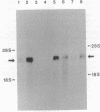Abstract
A functional cDNA clone for the histamine H1 receptor was isolated from a cDNA library of bovine adrenal medulla by a combination of molecular cloning in an expression vector and electrophysiological assay in Xenopus oocytes. The H1 receptor cDNA encodes a protein of 491 amino acids (Mr 55,954) with seven putative transmembrane domains, illustrating the similarity to other receptors that couple with guanine nucleotide-binding regulatory proteins (G protein-coupled receptors). The sequence homology between the H1 and H2 receptors is not higher than that between the histamine H1 and m1-muscarinic receptors. The cloned receptor protein expressed in COS-7 cells bound specifically to [3H]mepyramine, an H1 receptor antagonist, and this binding was displaced by H1 receptor antagonists and histamine with affinities comparable with those in membranes of bovine adrenal medulla. H1 receptor mRNA was shown to be expressed in brain and in peripheral tissues, including lung, small intestine, and adrenal medulla. This investigation discloses the molecular nature of the H1 receptor--a receptor that mediates diverse neuronal and peripheral actions of histamine and that may be of therapeutic importance in allergy.
Full text
PDF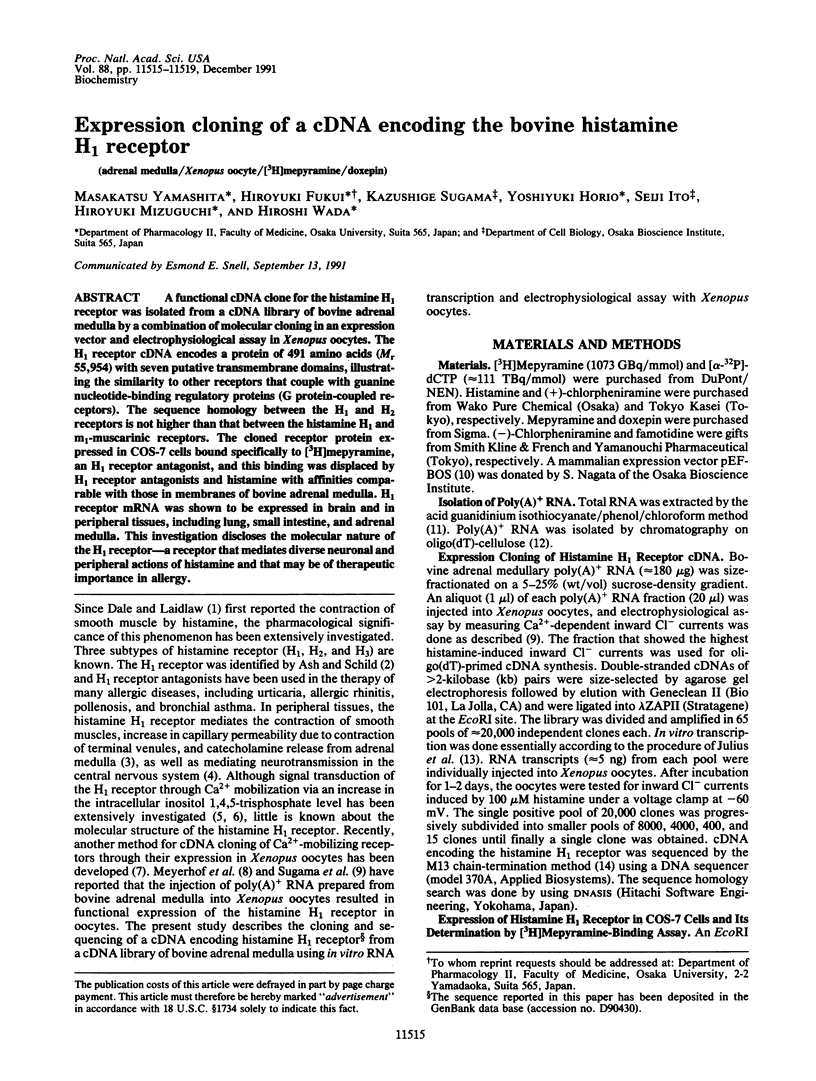
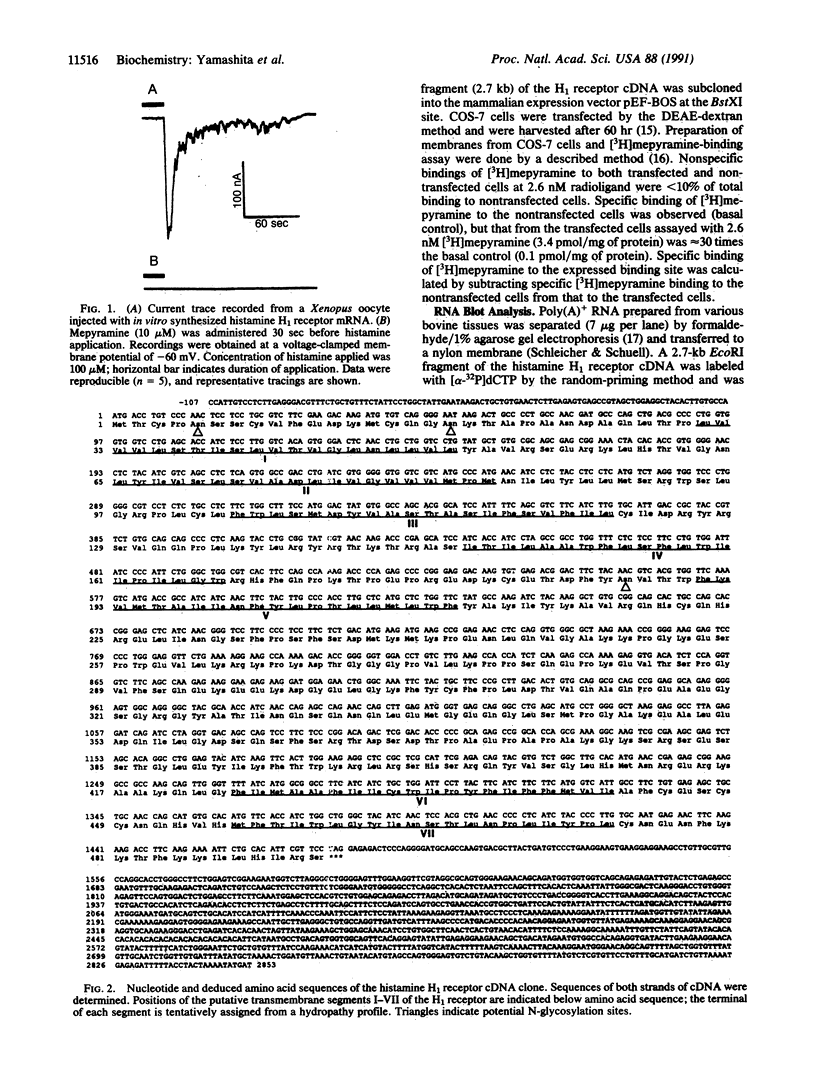
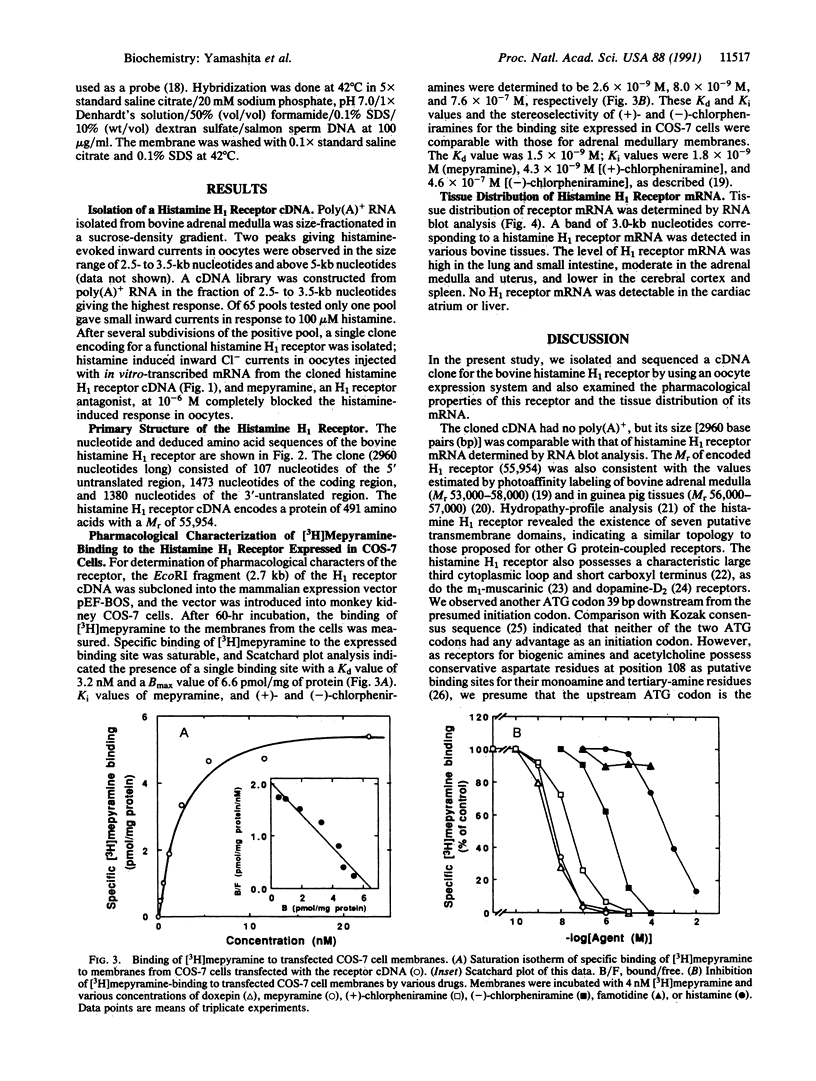
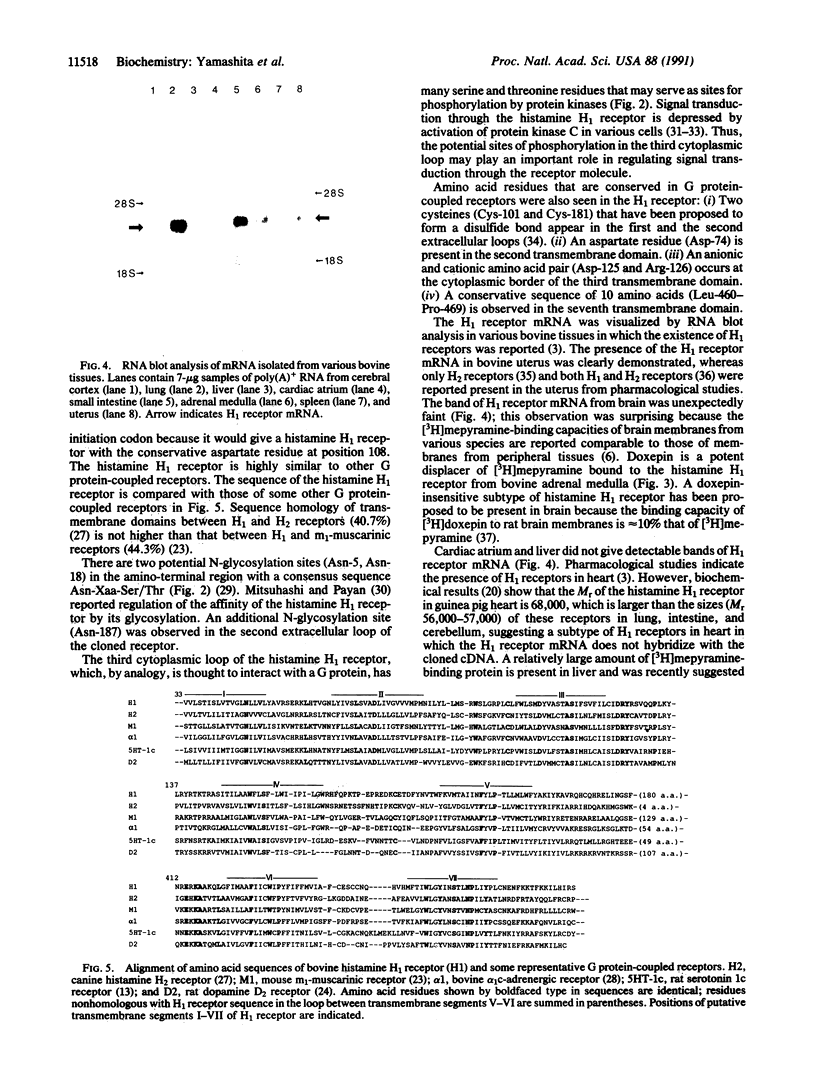
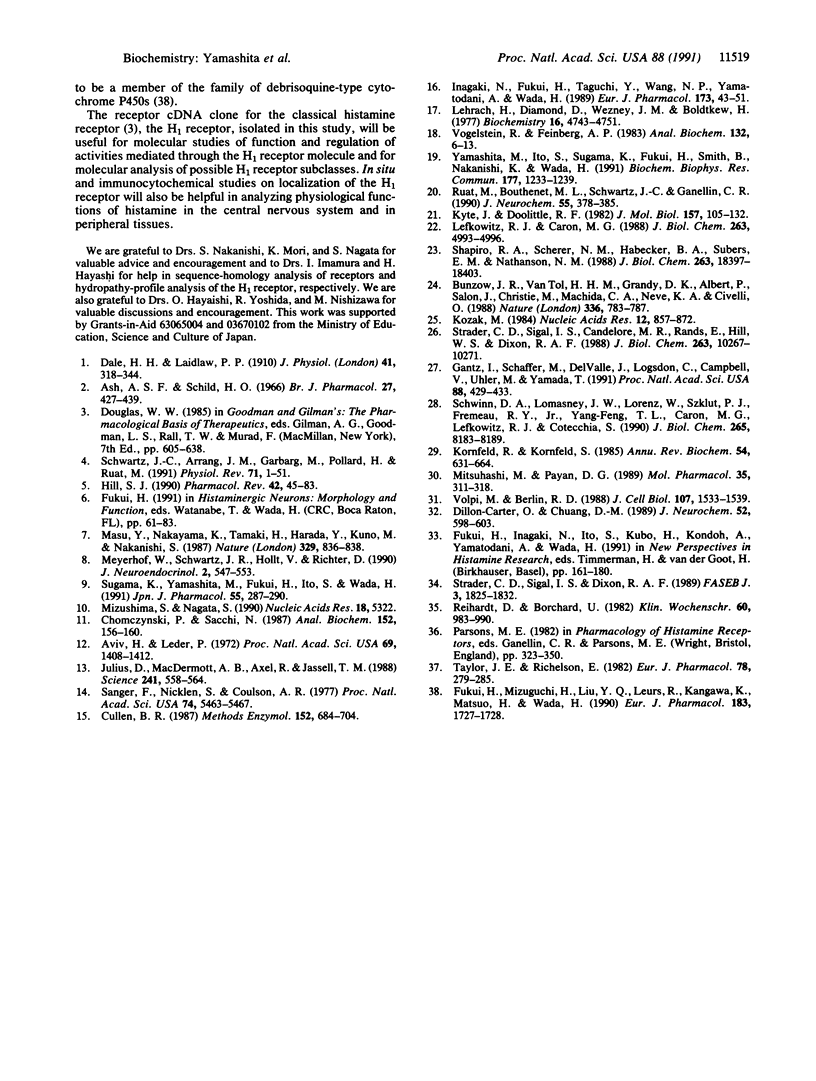
Images in this article
Selected References
These references are in PubMed. This may not be the complete list of references from this article.
- Ash A. S., Schild H. O. Receptors mediating some actions of histamine. Br J Pharmacol Chemother. 1966 Aug;27(2):427–439. doi: 10.1111/j.1476-5381.1966.tb01674.x. [DOI] [PMC free article] [PubMed] [Google Scholar]
- Aviv H., Leder P. Purification of biologically active globin messenger RNA by chromatography on oligothymidylic acid-cellulose. Proc Natl Acad Sci U S A. 1972 Jun;69(6):1408–1412. doi: 10.1073/pnas.69.6.1408. [DOI] [PMC free article] [PubMed] [Google Scholar]
- Bunzow J. R., Van Tol H. H., Grandy D. K., Albert P., Salon J., Christie M., Machida C. A., Neve K. A., Civelli O. Cloning and expression of a rat D2 dopamine receptor cDNA. Nature. 1988 Dec 22;336(6201):783–787. doi: 10.1038/336783a0. [DOI] [PubMed] [Google Scholar]
- Chomczynski P., Sacchi N. Single-step method of RNA isolation by acid guanidinium thiocyanate-phenol-chloroform extraction. Anal Biochem. 1987 Apr;162(1):156–159. doi: 10.1006/abio.1987.9999. [DOI] [PubMed] [Google Scholar]
- Cullen B. R. Use of eukaryotic expression technology in the functional analysis of cloned genes. Methods Enzymol. 1987;152:684–704. doi: 10.1016/0076-6879(87)52074-2. [DOI] [PubMed] [Google Scholar]
- Dale H. H., Laidlaw P. P. The physiological action of beta-iminazolylethylamine. J Physiol. 1910 Dec 31;41(5):318–344. doi: 10.1113/jphysiol.1910.sp001406. [DOI] [PMC free article] [PubMed] [Google Scholar]
- Dillon-Carter O., Chuang D. M. Homologous desensitization of muscarinic cholinergic, histaminergic, adrenergic, and serotonergic receptors coupled to phospholipase C in cerebellar granule cells. J Neurochem. 1989 Feb;52(2):598–603. doi: 10.1111/j.1471-4159.1989.tb09161.x. [DOI] [PubMed] [Google Scholar]
- Feinberg A. P., Vogelstein B. A technique for radiolabeling DNA restriction endonuclease fragments to high specific activity. Anal Biochem. 1983 Jul 1;132(1):6–13. doi: 10.1016/0003-2697(83)90418-9. [DOI] [PubMed] [Google Scholar]
- Fukui H., Inagaki N., Ito S., Kubo A., Kondoh H., Yamatodani A., Wada H. Histamine H1-receptors on astrocytes in primary cultures: a possible target for histaminergic neurones. Agents Actions Suppl. 1991;33:161–180. doi: 10.1007/978-3-0348-7309-3_12. [DOI] [PubMed] [Google Scholar]
- Gantz I., Schäffer M., DelValle J., Logsdon C., Campbell V., Uhler M., Yamada T. Molecular cloning of a gene encoding the histamine H2 receptor. Proc Natl Acad Sci U S A. 1991 Jan 15;88(2):429–433. doi: 10.1073/pnas.88.2.429. [DOI] [PMC free article] [PubMed] [Google Scholar]
- Hill S. J. Distribution, properties, and functional characteristics of three classes of histamine receptor. Pharmacol Rev. 1990 Mar;42(1):45–83. [PubMed] [Google Scholar]
- Inagaki N., Fukui H., Taguchi Y., Wang N. P., Yamatodani A., Wada H. Characterization of histamine H1-receptors on astrocytes in primary culture: [3H]mepyramine binding studies. Eur J Pharmacol. 1989 Nov 28;173(1):43–51. doi: 10.1016/0014-2999(89)90007-1. [DOI] [PubMed] [Google Scholar]
- Julius D., MacDermott A. B., Axel R., Jessell T. M. Molecular characterization of a functional cDNA encoding the serotonin 1c receptor. Science. 1988 Jul 29;241(4865):558–564. doi: 10.1126/science.3399891. [DOI] [PubMed] [Google Scholar]
- Kornfeld R., Kornfeld S. Assembly of asparagine-linked oligosaccharides. Annu Rev Biochem. 1985;54:631–664. doi: 10.1146/annurev.bi.54.070185.003215. [DOI] [PubMed] [Google Scholar]
- Kozak M. Compilation and analysis of sequences upstream from the translational start site in eukaryotic mRNAs. Nucleic Acids Res. 1984 Jan 25;12(2):857–872. doi: 10.1093/nar/12.2.857. [DOI] [PMC free article] [PubMed] [Google Scholar]
- Kyte J., Doolittle R. F. A simple method for displaying the hydropathic character of a protein. J Mol Biol. 1982 May 5;157(1):105–132. doi: 10.1016/0022-2836(82)90515-0. [DOI] [PubMed] [Google Scholar]
- Lefkowitz R. J., Caron M. G. Adrenergic receptors. Models for the study of receptors coupled to guanine nucleotide regulatory proteins. J Biol Chem. 1988 Apr 15;263(11):4993–4996. [PubMed] [Google Scholar]
- Lehrach H., Diamond D., Wozney J. M., Boedtker H. RNA molecular weight determinations by gel electrophoresis under denaturing conditions, a critical reexamination. Biochemistry. 1977 Oct 18;16(21):4743–4751. doi: 10.1021/bi00640a033. [DOI] [PubMed] [Google Scholar]
- Masu Y., Nakayama K., Tamaki H., Harada Y., Kuno M., Nakanishi S. cDNA cloning of bovine substance-K receptor through oocyte expression system. 1987 Oct 29-Nov 4Nature. 329(6142):836–838. doi: 10.1038/329836a0. [DOI] [PubMed] [Google Scholar]
- Mitsuhashi M., Payan D. G. Receptor glycosylation regulates the affinity of histamine H1 receptors during smooth muscle cell differentiation. Mol Pharmacol. 1989 Mar;35(3):311–318. [PubMed] [Google Scholar]
- Mizushima S., Nagata S. pEF-BOS, a powerful mammalian expression vector. Nucleic Acids Res. 1990 Sep 11;18(17):5322–5322. doi: 10.1093/nar/18.17.5322. [DOI] [PMC free article] [PubMed] [Google Scholar]
- Reinhardt D., Borchard U. H1-receptor antagonists: comparative pharmacology and clinical use. Klin Wochenschr. 1982 Sep 1;60(17):983–990. doi: 10.1007/BF01716959. [DOI] [PubMed] [Google Scholar]
- Ruat M., Bouthenet M. L., Schwartz J. C., Ganellin C. R. Histamine H1-receptor in heart: unique electrophoretic mobility and autoradiographic localization. J Neurochem. 1990 Aug;55(2):379–385. doi: 10.1111/j.1471-4159.1990.tb04148.x. [DOI] [PubMed] [Google Scholar]
- Sanger F., Nicklen S., Coulson A. R. DNA sequencing with chain-terminating inhibitors. Proc Natl Acad Sci U S A. 1977 Dec;74(12):5463–5467. doi: 10.1073/pnas.74.12.5463. [DOI] [PMC free article] [PubMed] [Google Scholar]
- Schwartz J. C., Arrang J. M., Garbarg M., Pollard H., Ruat M. Histaminergic transmission in the mammalian brain. Physiol Rev. 1991 Jan;71(1):1–51. doi: 10.1152/physrev.1991.71.1.1. [DOI] [PubMed] [Google Scholar]
- Schwinn D. A., Lomasney J. W., Lorenz W., Szklut P. J., Fremeau R. T., Jr, Yang-Feng T. L., Caron M. G., Lefkowitz R. J., Cotecchia S. Molecular cloning and expression of the cDNA for a novel alpha 1-adrenergic receptor subtype. J Biol Chem. 1990 May 15;265(14):8183–8189. [PubMed] [Google Scholar]
- Shapiro R. A., Scherer N. M., Habecker B. A., Subers E. M., Nathanson N. M. Isolation, sequence, and functional expression of the mouse M1 muscarinic acetylcholine receptor gene. J Biol Chem. 1988 Dec 5;263(34):18397–18403. [PubMed] [Google Scholar]
- Strader C. D., Sigal I. S., Candelore M. R., Rands E., Hill W. S., Dixon R. A. Conserved aspartic acid residues 79 and 113 of the beta-adrenergic receptor have different roles in receptor function. J Biol Chem. 1988 Jul 25;263(21):10267–10271. [PubMed] [Google Scholar]
- Strader C. D., Sigal I. S., Dixon R. A. Structural basis of beta-adrenergic receptor function. FASEB J. 1989 May;3(7):1825–1832. doi: 10.1096/fasebj.3.7.2541037. [DOI] [PubMed] [Google Scholar]
- Sugama K., Yamashita M., Fukui H., Ito S., Wada H. Functional expression of H1-histaminergic receptors in Xenopus laevis oocytes injected with bovine adrenal medullary mRNA. Jpn J Pharmacol. 1991 Feb;55(2):287–290. doi: 10.1254/jjp.55.287. [DOI] [PubMed] [Google Scholar]
- Taylor J. E., Richelson E. High-affinity binding of [3H]doxepin to histamine H1-receptors in rat brain: possible identification of a subclass of histamine H1-receptors. Eur J Pharmacol. 1982 Mar 12;78(3):279–285. doi: 10.1016/0014-2999(82)90029-2. [DOI] [PubMed] [Google Scholar]
- Yamashita M., Ito S., Sugama K., Fukui H., Smith B., Nakanishi K., Wada H. Biochemical characterization of histamine H1 receptors in bovine adrenal medulla. Biochem Biophys Res Commun. 1991 Jun 28;177(3):1233–1239. doi: 10.1016/0006-291x(91)90673-u. [DOI] [PubMed] [Google Scholar]



